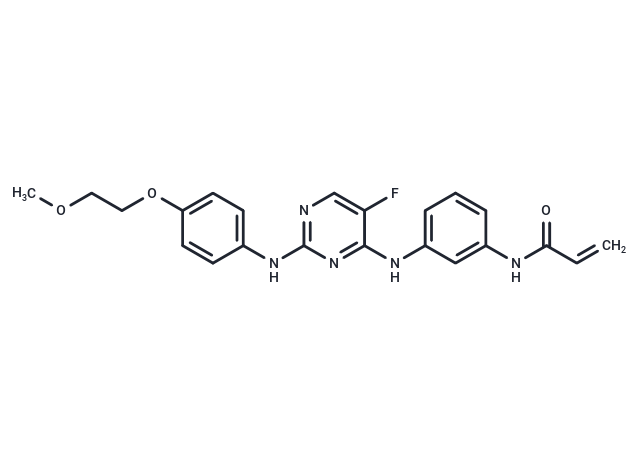Shopping Cart
- Remove All
 Your shopping cart is currently empty
Your shopping cart is currently empty

Spebrutinib (LMK-435) is an orally bioavailable, selective inhibitor of Bruton's agammaglobulinemia tyrosine kinase (BTK), with potential antineoplastic activity.

| Pack Size | Price | Availability | Quantity |
|---|---|---|---|
| 2 mg | $35 | In Stock | |
| 5 mg | $53 | In Stock | |
| 10 mg | $77 | In Stock | |
| 25 mg | $100 | In Stock | |
| 50 mg | $126 | In Stock | |
| 100 mg | $207 | In Stock | |
| 1 mL x 10 mM (in DMSO) | $57 | In Stock |
| Description | Spebrutinib (LMK-435) is an orally bioavailable, selective inhibitor of Bruton's agammaglobulinemia tyrosine kinase (BTK), with potential antineoplastic activity. |
| Targets&IC50 | BTK:<0.5 nM |
| In vitro | Oral administration of 3-30 mg/kg AVL-292 suppresses clinical symptoms of inflammation in a mouse model of collagen-induced arthritis, including the reduction of joint and paw swelling as well as visible redness in the affected paws. |
| In vivo | AVL-292 inhibits the activity of BTK, subsequently suppressing B-cell proliferation with an EC50 of 3 nM. Additionally, AVL-292 exerts an inhibitory effect on BTK expressed in Ramos cells, with an EC50 of 8 nM, demonstrating dose-dependency, and inhibits the downstream BCR pathway. |
| Kinase Assay | Procedures for BTK OMNIA Assay: The Omnia continuous read assay is performed essentially as described by the vendor. The assay conditions are: 40 μM ATP (1X KMATP), 10 μM Y5-Sox, and 10 nM BTK enzyme. Briefly, a substrate mix containing 1.13X ATP and the Y5 Sox substrate is first prepared in 1X Omnia Kinase Reaction Buffer (KRB) consisting of 20 mM Tris, pH 7.5, 5 mM MgCl2, 1 mM EGTA, 5 mM?β-glycerophosphate, 5% glycerol, and 0.2 mM DTT. For IC50 measurements, 5 μL of enzyme are incubated with serially diluted (3-fold) compounds prepared in 50% DMSO in a Corning (#3574) 384-well, white, non-binding surface microtiter plate at 25°C for 30 min. Kinase reactions are started with the addition of 45 μL of the ATP/Y5 substrate mix and monitored at λex360/λem485 in a Synergy 4 plate reader for 60 minutes. Progress curves from each well are examined for linear reaction kinetics and fit statistics. Initial velocity from each reaction is determined from the slope of a plot of relative fluorescence units versus time and then plotted against inhibitor concentration to estimate IC50 using the Response, Variable Slope model in GraphPad Prism from GraphPad Software. |
| Cell Research | A suspension of resting purified na?ve human B cells isolated by negative selection in RPMI is prepared at 0.4–0.5 × 106 cells/ml. Cells are mixed together with α-human IgM (final concentration of 5 μg/ml in each well) and vehicle (dimethyl sulfoxide) or AVL-292 (final concentrations of 0.01, 0.1, 1.0, 10.0, 100.0, or 1000 nM per well) and seeded in a 96-well plate. Cells are incubated for 56 hours in a humidified incubator maintained at 37°C and 5% CO2. 3H-Thymidine is added (final concentration of 1 μCi in each well) and cells are incubated overnight, harvested, and measured for 3H incorporation. Experiments are performed in triplicate.(Only for Reference) |
| Alias | LMK-435, CC-292, AVL-292 |
| Molecular Weight | 423.44 |
| Formula | C22H22FN5O3 |
| Cas No. | 1202757-89-8 |
| Smiles | COCCOc1ccc(Nc2ncc(F)c(Nc3cccc(NC(=O)C=C)c3)n2)cc1 |
| Relative Density. | 1.322 g/cm3 (Predicted) |
| Storage | Powder: -20°C for 3 years | In solvent: -80°C for 1 year | Shipping with blue ice. | |||||||||||||||||||||||||||||||||||
| Solubility Information | Ethanol: < 1 mg/mL (insoluble or slightly soluble) DMSO: 79 mg/mL (186.57 mM), Sonication is recommended. H2O: < 1 mg/mL (insoluble or slightly soluble) | |||||||||||||||||||||||||||||||||||
Solution Preparation Table | ||||||||||||||||||||||||||||||||||||
DMSO
| ||||||||||||||||||||||||||||||||||||

Copyright © 2015-2025 TargetMol Chemicals Inc. All Rights Reserved.